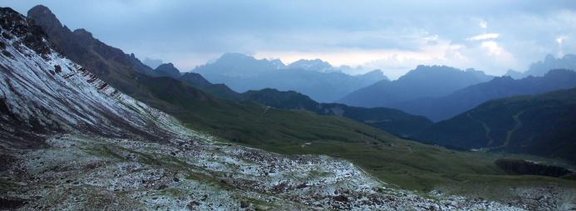MICIA: Multiscale Interactions in Convection Initiation in the Alps

The track of a thunderstorm in a mountainous area, made evident by a narrow strip of hail deposited on the ground. Clear skies are visible in the background, at a distance of approximately 25 km.
One of the most visually striking impacts of mountains on the atmospheric circulation is the promotion of cloud formation. Clouds develop when water vapour condenses in an air mass whose temperature is decreasing. Mountains favour this process primarily by forcing upward air motion. In fact, rising air masses cool down as they encounter lower atmospheric pressure during their ascent.
Meteorologists distinguish between stratiform and cumuliform clouds. Stratiform clouds are developed mostly in the horizontal direction and have a layered appearance. Cumuliform clouds, instead, have a large vertical extent and are caused by convection, a form of circulation characterized by vigorous vertical motion. The clouds with the largest vertical development, cumulonimbus clouds, may cause heavy rainfall, thunderstorms and other severe weather.
The project MICIA aims at improving the knowledge of the processes that cause the formation of cumulus clouds near mountains during summer. In this season, storms and heavy rainfall occur over and near mountains more frequently than over plains. Forecasts of these phenomena are often inaccurate, because storms may form near mountains even if the regional weather conditions seem only marginally supportive. Often, convection initiation is affected by meteorological processes that operate at very different spatial and temporal scales. For instance, even if slowly changing weather conditions remain favourable to storm occurrence continuously for a few days and uniformly over several thousand kilometres, storms can be short-lived and localized. In fact, the initial stage of a storm may correspond to a single quickly evolving convective plume with a size of only a few hundred meters. The very wide spectrum of relevant scales poses a challenge both to the scientific understanding and to the forecasting of convective storms.
The MICIA project addresses two main knowledge gaps, in particular the possible impacts of mountain waves and of terrain-induced breezes, like valley winds, on storm initiation and development. These topics are investigated through simulations with state-of-the-art high-resolution numerical weather prediction models. Research plans also include the study of a series of summertime storms observed in the Alpine area, using ensemble numerical simulations to complement the analysis of existing observations.
Project
Project Leader:
Mathias ROTACH
Former Project Leader:
Serafin Stefano
Members:
Matthias GÖBEL
Maria SILLER
Funding Agencies:
Austrian Science Fund (FWF): P30808-N32 (https://www.fwf.ac.at/)
Project Duration:
01/03/2018 to 28/02/2022
